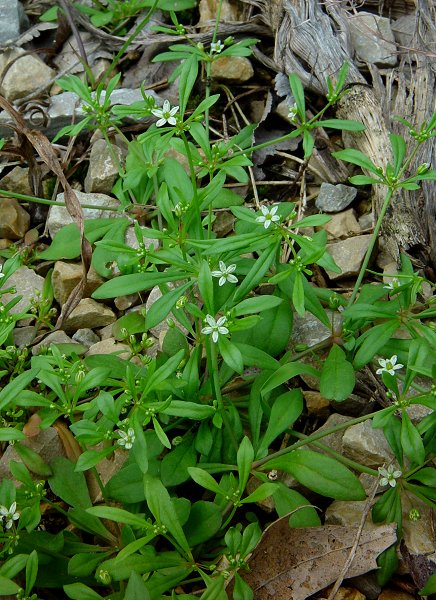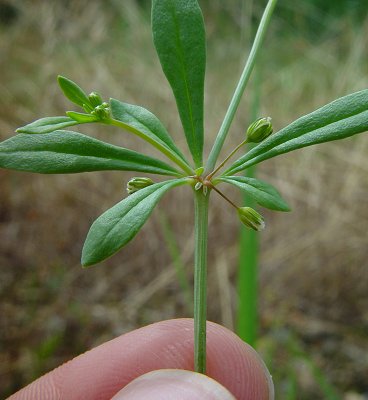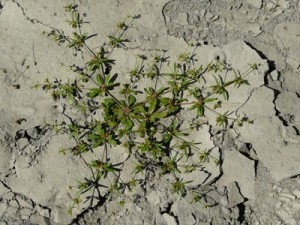When it comes to Carpetweed you need to know only two things: It grows nearly everywhere, or will. And the plant above ground is edible. To quote Cornucopia II, page 153:
“The entire plant can be cooked and eaten as a potherb, or added to vegetable soups during the last minutes of cooking.” Yes, I know it says “entire” plant but that usually does not include roots. When roots are edible they are usually mentioned separately.

Harvard Professor Merritt Fernald.
Opinions of the species do vary. It is a fast-spreading weed from Tropical America that can survive northern winters, though there is some debate about that. Some folks say it will cover everything in sight. Merritt Fernald, left, no botanical slouch and the leading expert of his day, wrote on page 188 in Edible Plants of Eastern North America: “It is too small for most people to gather, except when very hungry.” Now you have the opinion spread: Will cover every thing in sight, and, too small to be bothered with. Fernald was not beyond eating this or that strange plant but as he wrote in WWII he was concerned about the growing population and dwindling agricultural resources.
Botanists know Carpetweed is spreading rapidly because they have herbarium examples from almost two hundred years ago and then later in other areas. It has… carpeted… North America and is working on China. There are reports of it in Australia. Carpetweed is also found in Mexico, West Indies, Central America, South America, Eurasia, and Africa. Not every place, however, is graced with Carpetweed. It is absent from Utah — too dry — and Alaska, too cold. I found no complaints out of Western Europe, yet.
Botanically the weed is called Mollugo verticillata (mol-LOO-go ver-tee-see-LAH-tuh) which for once actually makes some sense. Often a botanical name has nothing to do with the plant nor describes it. This time it does. Mollugo used to be the genus name for the Galiums, which this plant does resembles. They are better known as Goose Grass, Cheavers, and Cleavers. And verticillata refers to the whorl of leaves the plant has at each node, which goes even further back to Vermes for worms. Mollugo is Dead Latin’s bastardization of the Greek mollis which means soft. Other names in English include Green Carpetweed, Indian Chickweed, and Devil’s Grip. In China it is 种棱粟米草 or zhong leng su mi cao. Botanists have been arguing for years whether there are two genera and exactly how many species there are. Confounding the issue is the fact the plant can vary a lot in the way it looks. Botanists say it is doubtful a species able to overwinter is the same as the original in Tropical America but no consensus has been reached… as if it is a pressing matter.
As far as opinions go Fernald may win. To find Carpetweed look down for a spot of green one to two feet across, low-growing, usually in dry areas. such as a college lawn watered by rain not irrigation. I think that’s where I last saw an excellent patch of it in Jacksonville at the state college there. Carpetweed can, however, cover more ground but apparently not enough to get into foraging books.
Man, by the way, is not the only nibbler: Birds and small mammals eat the seeds. Lastly consuming Carpetweed may increase your levels of nitric oxide. In theory that should lower blood pressure.
Green Deane’s “Itemized” Plant Profile: Carpetweed
IDENTIFICATION: Mollugo verticillata: It’s a late-germinating, many-branched summer annual forming circular patches one to two feet in diameter, sometimes much larger, often much less. Leaves are in whorls of 3 to 8 at each node. Leaves attach directly to the stem (sessile) widest above the middle and tapering to the base, often shiny. Don’t mistake for Galiums which show up in the spring. Galiums are rough to the touch, Carpetweed is smooth. Galiums tend to grow up into a tangled mass, Carpetweed grows low, like a carpet. Galiums were bunched up to strain cheese through. Can’t do that with Carpetweed. Stems are smooth, branch a lot, lying on the ground with the ends turning up. Flowers are very small, five white sepals (look like petals) in clusters of two to five on long stalks. Red to orange seeds in an egg-shaped capsule.
TIME OF YEAR: Warm months in northern climes nearly year round in warm climes, flowers summer to early fall
ENVIRONMENT: Fields, gardens, roadsides, moist to dry soils, sand.
METHOD OF PREPARATION: The entire plant above ground can be boiled. Leaves are more preferable; young and tender — the meristem stage — even better.




